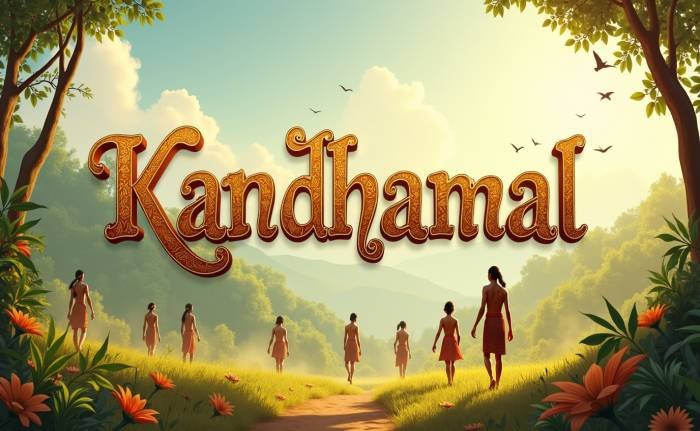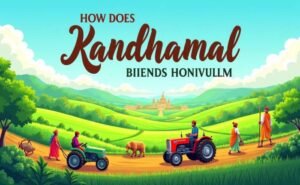How Kandhamal Is Shaping Sustainable Farming in Eastern India

1. Why Is Kandhamal’s Agriculture Unique?
Why is Kandhamal’s farming special? Folks, Kandhamal’s farming blends tribal traditions with eco-friendly ways. Its diverse crops and Kutia Kondh skills make it a model. Let me show you why Kandhamal’s green approach teaches Eastern India a lot.
It sits in Odisha’s hills with a great climate for crops. The Kutia Kondh grow millets and roots without chemicals, keeping soil healthy. I saw farmers plant millets by hand on a trip there.
The area’s rural life helps farming grow. Tribal farmers use forest foods like yams to stay fed. Diverse crops avoid the risks of single crops. I talked to a farmer who was proud of the old ways.
2. How Did Kandhamal Revive Crop Biodiversity?
How did Kandhamal bring back its crops? Friends, Kandhamal’s work to save old crops is awesome. After losing many to single-crop farming, farmers now grow traditional seeds. I’ll tell you how seed banks and festivals I saw keep food and nutrition strong.
The Kutia Kondh once grew many crops, but the Green Revolution cut this down (ICAR, 2023). NIRMAN’s seed banks save old seeds. I went to a Kandhamal festival where farmers shared millets. These crops grow without chemicals, unlike new ones.
Seed festivals build community bonds. Farmers share tips, needing less from markets. This keeps nutrition strong. Kandhamal’s way is a guide for others. Picture: Chart showing Kandhamal’s crop drop and rise from 1970 to 2025.
3. What Role Does Turmeric Play in Kandhamal’s Economy?
Why is Kandhamal’s turmeric a big deal? Guys, Kandhamal’s special turmeric boosts money while staying green. It grows strong and helps farmers, especially women. I’ll share how this crop, glowing in fields I visited, lifts Kandhamal’s economy.
Kandhamal’s turmeric grows in rich soil without chemicals. Its GI tag from 2019 brings global buyers (WIPO, 2019). I tried turmeric tea at a cooperative—so good! Women farmers lead, gaining monetary and freedom.
Cooperatives sell turmeric directly, skipping middlemen. NIRMAN’s training improves skills. This keeps money steady without harming nature. Kandhamal’s turmeric is a model. Picture: Bright turmeric fields with women farmers in it.
4. Who Are the Key Players in Kandhamal’s Farming?
Who makes Kandhamal’s farming green? Let me tell you, the Kutia Kondh and helpers drive this change. From farmers to NGOs, they make it work. I’ll share how their teamwork, seen on my visit, lifts communities.
The Kutia Kondh are great at mixed farming. Women like Yashoda Majhi run seed banks, as I saw. NIRMAN gives training, and government funds help green farming (Odisha Agriculture, 2024).
Local leaders push crops like cauliflower. Farmers mix new tools with old ways, raising yields. This teamwork inspires others. Kandhamal’s spirit spreads. Picture: Kutia Kondh farmer and NIRMAN worker talking seeds.
5. How Do Tribal Communities Ensure Food Security?
How does Kandhamal keep food secure? Friends, Kandhamal’s tribal farmers use green ways to stay fed. Their mixed crops and forest foods are smart. I’ll show how these, seen in action, cut market needs.
The Kutia Kondh grow millets, beans, and roots on small land. They add forest foods like mushrooms for meals. I ate wild yams at a it market—yummy! Seed banks save old crops.
Green methods keep soil rich, fighting climate issues. Women lead, tying communities together. Tradition and green farming mix well. it inspires. Picture: Chart of Kandhamal’s food sources, from crops to forest.
6. Why Is Millet Farming Gaining Popularity in Kandhamal?
Why are millets big in Kandhamal? Guys, millets are back in Kandhamal big time. They’re tough and healthy. I’ll tell you how these crops, seen in fields I visited, help tribal lives.
Millets grow in Kandhamal’s hills with little water. They handle drought well (ICAR, 2023). Kutia Kondh know-how guides planting. These crops boost diets. Seed banks give easy access.
Farmers share seeds at festivals, building bonds. Millets need no chemicals, saving soil. This cuts reliance on big crops. Itleads the way. Picture: Millet fields in it with farmers picking.
7. How Does Kandhamal Blend Tradition with Modern Farming?

How does Kandhamal mix old and new farming? Folks, Kandhamal’s farmers blend tribal ways with new tools perfectly. Their old knowledge plus water ponds makes a green model. I’ll share what I saw.
The Kutia Kondh use mixed crops to keep soil good. Water ponds, seen on my trip, raise yields. NIRMAN teaches green methods. This mix gives big harvests without harm. Government funds bring tools.
Farmers use new ways but keep traditions. This boosts money and strength. Kandhamal’s way works for tribal areas. It’s awesome to see. Picture: Chart comparing old and new farming in it.
8. What Economic Benefits Come from Sustainable Farming?
What money wins does Kandhamal get? Guys, Kandhamal’s green ways lift tribal wallets. Turmeric and strawberries make steady cash. I’ll share how this farming, seen at a market, grows money.
Turmeric and strawberries sell for high prices. Women-led groups sell directly, skipping middlemen. Green methods cut costs, raising profits. Funds help grow crops like cauliflower (Odisha Agriculture, 2024).
Diverse crops lower financial risks. Farmers earn from forest foods and tourism. Training builds skills for long-term wins. it inspires. Picture: Tribal woman selling turmeric at a it market.
9. How Does Kandhamal Address Climate Challenges?
How does Kandhamal fight climate issues? Friends, Kandhamal’s farmers use smart ways to handle climate. Tough crops and water systems keep them green. I’ll share how these, seen in my research, help Eastern India.
Millets and beans grow in Kandhamal’s tough climate. Water ponds handle low rainfall. Green methods keep soil wet, fighting droughts (ICAR, 2023). Seed banks give strong seeds. These ways harm nature less.
NGOs teach water-saving ways. Government funds push tough crops. Tribal know-how picks crops for changing weather. Kandhamal keeps yielding green. Picture: Chart on Kandhamal’s climate-smart farming.
10. Who Benefits Most from Kandhamal’s Farming Practices?
Who gains most from Kandhamal’s green farming? Let me tell you, tribal women and small farmers win big. Their greenways lift communities. I’ll share how these efforts, seen on my trip, bring money.
Women like Yashoda Majhi run seed banks. Turmeric brings steady cash, as I saw at a market. Green farming cuts costs for poor farmers. NIRMAN’s training lifts women (NIRMAN, 2024).
Funds target small farmers. NGOs train women, growing their roles. Greenways ensure the family wins. it inspires fairness. Picture: Women farmers working together in a it group.
11. Why Is Off-Season Farming Thriving in Kandhamal?
Why does off-season farming rock? Guys, Kandhamal’s weather is great for crops like cauliflower. These boost cash greenly. I’ll show how this farming, seen in action, uses Kandhamal’s conditions.
Kandhamal’s hills grow off-season veggies. Cauliflower covers much land with big yields (Odisha Agriculture, 2024). Farmers use green methods, saving money. The government gives seeds, and strawberries help women.
It spreads income and cuts monsoon needs. Farmers use few inputs, saving soil. Kandhamal’s success pulls regional eyes. It’s a model. Picture: Bright cauliflower field in itoff-season.
12. How Does Kandhamal Preserve Its Cultural Heritage?
How does farming keep Kandhamal’s culture strong? Friends, Kandhamal’s green farming ties to tribal roots. Seed festivals and old ways keep the Kutia Kondh identity. I’ll share how these, seen at a festival, save culture.
Seed festivals celebrate crop variety. Farmers share old seeds, keeping knowledge. Mixed farming shows tribal love for nature. NIRMAN backs these festivals (NIRMAN, 2024). These ways fight single crops.
Old crops like millets hold cultural value. Women teach kids old ways. Farming honors ancestors. it model inspires. Picture: itseed festival with tribal farmers.
13. What Is the Role of NGOs in Kandhamal’s Farming?
What do NGOs do for Kandhamal’s farming? Folks, NGOs like NIRMAN are huge in green farming. They train farmers and save seeds. I’ll share how their work, seen in a workshop, drives change.
NIRMAN saves crop variety with seed banks. It teaches green methods, as I saw. Women gain leadership skills. NGOs link farmers to government help (NIRMAN, 2024). Their work promotes green practices.
They push climate-tough crops. Training covers water and soil care. NGOs help tribes fight big farm pressures. Kandhamal’s model shows their power. Picture: Chart on NIRMAN’s help to farming.
14. How Can Kandhamal Inspire Eastern India?
How can Kandhamal’s model spread? Guys, Kandhamal’s green farming is a guide for tribal areas. Its crop variety and teamwork can work elsewhere. I’ll share how these, seen in my research, inspire green farming.
Kandhamal’s millets fight climate issues. Turmeric and strawberries make money. Seed banks keep seed control, as I saw at a festival. These fit similar lands. Government-NGO teams spread their reach.
Training can share Kandhamal’s know-how. Mixed crops and water systems work elsewhere. Women-led groups inspire tribes. Kandhamal’s plans excite. Picture: it farmers teaching others in Eastern India.
Conclusion
Hey everyone, Kandhamal’s green farming, led by Kutia Kondh, mixes old and new. From millets to famous turmeric, it keeps food and money strong. It’s tough; women-led ways inspire Eastern India, as I saw myself.
FAQs
What kind of soil is found in Kandhamal?
Kandhamal has red-laterite soil. It is acidic and low in water-holding capacity.
What industries are in Kandhamal?
Kandhamal has cottage and agro-based industries. It also has graphite reserves in Tumdibandha.
What is the culture like in Kandhamal?
Kandhamal has a rich tribal culture. People make crafts like Dokra, bamboo, and terracotta items.



